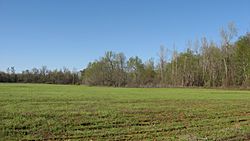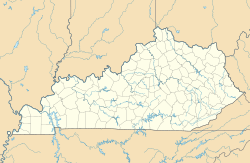Marshall Site facts for kids

Looking toward the site from the southwest
|
|
| Location | Bardwell, Kentucky, Carlisle County, Kentucky, |
|---|---|
| Region | Jackson Purchase |
| Coordinates | 36°53′52″N 89°5′5″W / 36.89778°N 89.08472°W |
| History | |
| Founded | 900 CE |
| Abandoned | 1300 CE |
| Cultures | Late Woodland period, Mississippian culture |
| Site notes | |
| Responsible body: Private | |
The Marshall Site (also known as 15CE27) is an ancient archaeological site located near Bardwell, Kentucky. It sits on a high piece of land overlooking the Mississippi River floodplain. This site was once a village of the Mississippian culture.
People lived here from about 900 CE to 1300 CE. This time is known as the James Bayou Phase in local history. The village was later abandoned. Its residents might have moved to the Turk Site, another nearby ancient village. The Marshall Site is also a few miles south of the famous Wickliffe Mounds Site.
What Was Found at the Marshall Site?
The Marshall Site was a large village. Archaeologists found signs that it once had platform mounds and earthworks. These are big piles of earth built by ancient people. It's not clear exactly when these earthworks were built.
This site is very important because it was studied a lot. It was also abandoned a long time ago. This means its ancient features were not disturbed by people living there later.
Digging for Clues: The 1985 Excavation
In 1985, a team of archaeologists from the University of Illinois dug at the Marshall Site. Students from their summer field school also helped. They explored four different areas of the site.
On the eastern side of a central hill, they found a large midden. A midden is like an ancient trash pile. It contained many layers of old materials. A piece of charcoal from this midden was tested. It showed that people lived there around 1027 CE.
On the western side of the hill, they found the remains of a house. This house was buried under another midden. Inside, they discovered Mississippian culture pottery. This pottery was made stronger with crushed mussel shells.
North of the hill, archaeologists found many long, straight features. These were likely the remains of several houses. It seems new houses were built one after another in the same spot.
Finally, they explored an area to the southwest of the hill. Not much was found there. They tested a horseshoe-shaped earthwork. But they couldn't learn much about it, except that it marked the southwest corner of the site.


